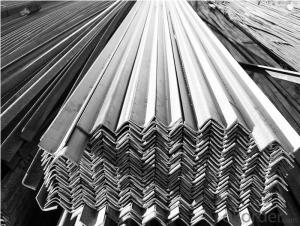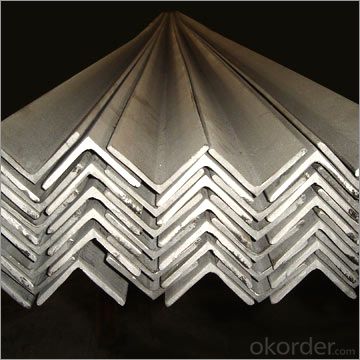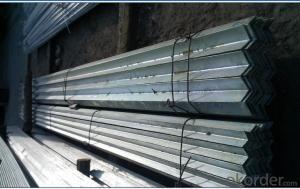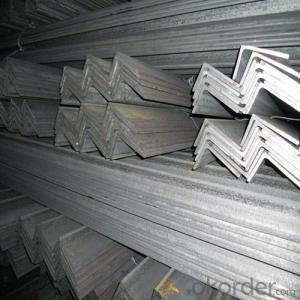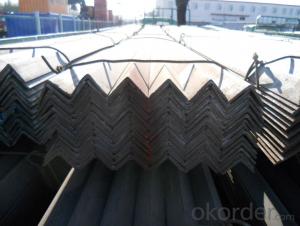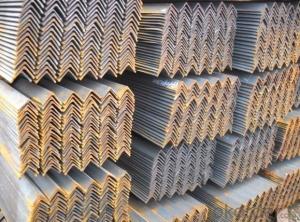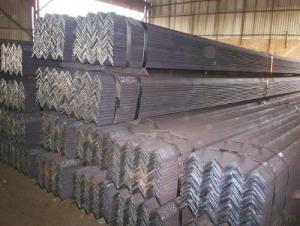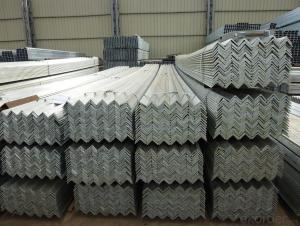30mm*6mm hot sell Equal Angle for construction
- Loading Port:
- Tianjin
- Payment Terms:
- TT OR LC
- Min Order Qty:
- 25 m.t.
- Supply Capability:
- 10000 m.t./month
OKorder Service Pledge
OKorder Financial Service
You Might Also Like
Product Description:
Specifications of Angle Steel
1. Invoicing on theoretical weight or actual weight as customer request
2. Length: 6m, 9m, 12m as following table
3. Sizes

Sizes: 25mm-250mm | ||
a*t | ||
25*2.5-4.0 | 70*6.0-9.0 | 130*9.0-15 |
30*2.5-6.6 | 75*6.0-9.0 | 140*10-14 |
36*3.0-5.0 | 80*5.0-10 | 150*10-20 |
38*2.3-6.0 | 90*7.0-10 | 160*10-16 |
40*3.0-5.0 | 100*6.0-12 | 175*12-15 |
45*4.0-6.0 | 110*8.0-10 | 180*12-18 |
50*4.0-6.0 | 120*6.0-15 | 200*14-25 |
60*4.0-8.0 | 125*8.0-14 | 250*25 |
5. Payment terms:
1).100% irrevocable L/C at sight.
2).30% T/T prepaid and the balance against the copy of B/L.
3).30% T/T prepaid and the balance against L/C
6.Material details:
Alloy No | Grade | Element (%) | |||||
C | Mn | S | P | Si | |||
|
|
|
|
|
|
| |
Q235 | B | 0.12—0.20 | 0.3—0.7 | ≤0.045 | ≤0.045 | ≤0.3 | |
|
|
|
|
|
|
| |
Alloy No | Grade | Yielding strength point( Mpa) | |||||
Thickness (mm) | |||||||
≤16 | >16--40 | >40--60 | >60--100 | ||||
≥ | |||||||
|
|
|
|
|
| ||
Q235 | B | 235 | 225 | 215 | 205 | ||
Alloy No | Grade | Tensile strength (Mpa) | Elongation after fracture (%) | ||||
Thickness (mm) | |||||||
| ≤16 | >16--40 | >40--60 | >60--100 | |||
≥ | |||||||
|
|
|
|
|
|
| |
Q235 | B | 375--500 | 26 | 25 | 24 | 23 | |
Usage & Applications of Angle Steel
According to the needs of different structures, Angle can compose to different force support component, and also can be the connections between components. It is widely used in various building structures and engineering structures such as roof beams, bridges, transmission towers, hoisting machinery and transport machinery, ships, industrial furnaces, reaction tower, container frame and warehouse etc.
Packaging & Delivery of Angle Steel
1. Packing: it is nude packed in bundles by steel wire rod
2. Bundle weight: not more than 3.5MT for bulk vessel; less than 3 MT for container load
3. Marks:
Color marking: There will be color marking on both end of the bundle for the cargo delivered by bulk vessel. That makes it easily to distinguish at the destination port.
Tag mark: there will be tag mark tied up on the bundles. The information usually including supplier logo and name, product name, made in China, shipping marks and other information request by the customer.
If loading by container the marking is not needed, but we will prepare it as customer request.
Production flow of Angle Steel
Material prepare (billet) —heat up—rough rolling—precision rolling—cooling—packing—storage and transportation
Packaging & Delivery of Equal Angle
1. Transportation: the goods are delivered by truck from mill to loading port, the maximum quantity can be loaded is around 40MTs by each truck. If the order quantity cannot reach the full truck loaded, the transportation cost per ton will be little higher than full load.
2. With bundles and load in 20 feet/40 feet container, or by bulk cargo, also we could do as customer's request.
3. Marks:
Color mark: There will be color marking on both end of the bundle for the cargo delivered by bulk vessel. That makes it easily to distinguish at the destination port.
Tag mark: There will be tag mark tied up on the bundles. The information usually including supplier logo and name, product name, made in China, shipping marks and other information request by the customer.
If loading by container the marking is not needed, but we will prepare it as customer request.

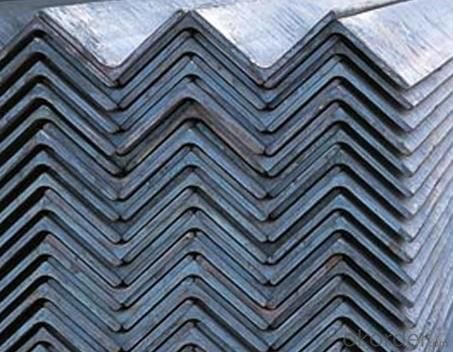
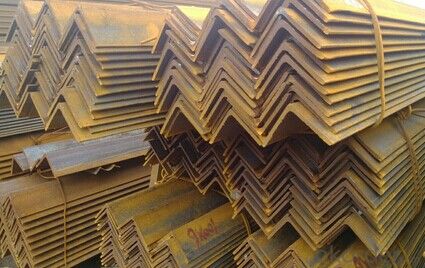
- Q: How do steel angles contribute to the sustainability of transportation systems?
- Steel angles contribute to the sustainability of transportation systems in several ways. Firstly, steel angles are widely used in the construction of infrastructure such as bridges, highways, and railway tracks. These structures have a longer lifespan and require fewer repairs and replacements compared to other materials, resulting in reduced maintenance costs and resource consumption. Moreover, steel angles are highly durable and resistant to harsh weather conditions, ensuring the longevity and safety of transportation systems. This durability minimizes the need for frequent repairs or replacement, reducing the overall environmental impact and carbon emissions associated with transportation infrastructure. Additionally, steel angles have a high strength-to-weight ratio, allowing for the design of lighter and more fuel-efficient vehicles. By using steel angles in the manufacturing of automobiles, trains, and ships, the weight of these vehicles can be reduced, leading to improved fuel efficiency and reduced greenhouse gas emissions during operation. Furthermore, steel angles can be easily recycled at the end of their life cycle. Steel is one of the most recycled materials globally, with a recycling rate of over 85%. Recycling steel angles not only reduces the demand for virgin steel production but also saves energy and reduces greenhouse gas emissions associated with the extraction and manufacturing processes. Overall, the use of steel angles in transportation systems contributes to their sustainability by promoting durability, reducing maintenance needs, improving fuel efficiency, and enabling efficient recycling. These factors collectively help to minimize the environmental impact and enhance the long-term viability of transportation infrastructure.
- Q: How do you determine the required thickness of a steel angle for a specific load?
- To determine the required thickness of a steel angle for a specific load, various factors need to be considered. These include the magnitude and direction of the load, the length and support conditions of the angle, and the desired safety factor. By analyzing these factors, engineers can utilize structural analysis techniques and calculations to determine the appropriate thickness of the steel angle that can withstand the given load without experiencing failure or excessive deflection.
- Q: What are the common uses for steel angles?
- Steel angles are commonly used in construction and engineering projects for various purposes such as providing structural support, bracing or reinforcing structures, framing walls and ceilings, creating edges or corners, and forming joints and connections between different components.
- Q: What are the environmental benefits of using steel angles?
- The environmental benefits of using steel angles include their high strength and durability, which allows for longer lifespan and reduced need for replacement. Steel angles are also recyclable, contributing to a circular economy by reducing the demand for raw materials and energy consumption. Furthermore, steel angles can be manufactured using recycled steel, reducing the carbon footprint and promoting sustainable practices in the construction industry.
- Q: How do steel angles contribute to the overall aesthetics of a structure?
- Steel angles can contribute to the overall aesthetics of a structure in multiple ways. Firstly, steel angles can be used as decorative elements to create interesting and visually appealing designs. They can be incorporated into the architectural design to add unique and distinctive features to the structure. For example, steel angles can be used to create patterns, shapes, or even sculptures that enhance the overall aesthetic appeal of the building. Additionally, steel angles can be used to create a sense of balance and symmetry in the structure. By strategically placing steel angles at specific locations, architects can create a visually pleasing and harmonious design. The use of steel angles can help to break up large, monotonous surfaces and add depth and dimension to the structure, making it more visually interesting. Furthermore, steel angles can contribute to the aesthetic appeal of a structure by providing a sleek and modern appearance. The clean lines and sharp edges of steel angles can give a contemporary and industrial look to the building, which is often desired in modern architecture. The use of steel angles can also convey a sense of strength and stability, which can be visually appealing and reassuring to observers. Lastly, steel angles can be utilized to enhance the overall structural integrity of the building. While aesthetics are important, it is also crucial to ensure the safety and stability of the structure. Steel angles can be strategically placed to provide additional support and reinforcement, ensuring that the building is not only visually appealing but also structurally sound. In conclusion, steel angles can contribute to the overall aesthetics of a structure by adding decorative elements, creating balance and symmetry, providing a sleek and modern appearance, and enhancing the structural integrity. By incorporating steel angles into the design, architects can create visually stunning buildings that are both aesthetically pleasing and structurally sound.
- Q: Can steel angles be used for foundation reinforcement?
- Indeed, foundation reinforcement can be accomplished using steel angles. In construction, steel angles find wide application, particularly in fortifying foundations. They are frequently employed to fortify the foundation walls by connecting the horizontal and vertical components, thereby enhancing strength and stability. Steel angles are easily installed and possess commendable resistance against bending and shearing forces, rendering them highly suitable for foundation reinforcement. Furthermore, steel angles exhibit durability, cost-effectiveness, and easy accessibility, thus making them a favored option for reinforcing foundations in numerous construction endeavors.
- Q: Can steel angles be used for bracing?
- Yes, steel angles can be used for bracing. Steel angles are commonly used as structural supports to provide strength and stability in various applications, including bracing in construction and engineering projects. Their L-shaped design allows them to distribute forces and resist bending, making them suitable for bracing purposes.
- Q: Can steel angles be used for storage rack systems?
- Yes, steel angles can be used for storage rack systems. Steel angles provide structural support and stability, making them a suitable choice for constructing storage racks that can hold heavy loads and withstand frequent use. The versatility and strength of steel angles make them a popular choice in various industrial and commercial storage applications.
- Q: How do you calculate the torsional capacity of a steel angle?
- In order to determine the torsional capacity of a steel angle, one must take into account both the material properties and dimensions of the angle. The torsional capacity refers to the maximum torque or twisting force that the angle can withstand without experiencing significant deformation or failure. To calculate the torsional capacity, the following steps can be followed: 1. Measure the dimensions of the steel angle, including thickness, width, and length, in order to determine the cross-sectional properties. These properties include the area moment of inertia (I) and the polar moment of inertia (J). These values provide information about the angle's resistance to torsional forces. 2. Obtain the material properties of the steel angle, such as the yield strength (σy) and the ultimate strength (σu). These values indicate the maximum stress that the material can withstand before permanent deformation or failure occurs. 3. Calculate the torsional stress on the angle by using the applied torque (T). The torsional stress (τ) is determined by dividing the torque by the polar moment of inertia (τ = T / J). This calculation reveals the amount of twisting force experienced by the angle. 4. Determine the safety factor by dividing the yield strength of the material by the calculated torsional stress (SF = σy / τ). The safety factor represents the ratio of the maximum stress that the angle can withstand (yield strength) to the actual stress it experiences. A higher safety factor indicates a greater margin of safety. 5. Compare the calculated safety factor to a desired value. Depending on the specific application and design requirements, a minimum safety factor may be specified. If the calculated safety factor is below the desired value, it suggests that the angle is not suitable for the intended torsional load, and alternative angles or design modifications may be necessary. It should be noted that these calculations offer an estimate of the torsional capacity, and other factors such as the presence of holes, welds, or other geometric irregularities can impact the actual torsional behavior of the angle. Therefore, it is advisable to consult relevant design codes or professional engineering resources for detailed calculations and recommendations specific to the intended application.
- Q: What are the different methods of surface preparation for steel angles before painting?
- There are several methods of surface preparation for steel angles before painting. The choice of method depends on the condition of the steel surface and the desired level of paint adhesion and durability. One common method is abrasive blasting, also known as sandblasting. This involves propelling abrasive particles against the steel surface to remove rust, mill scale, and other contaminants. Abrasive blasting not only cleans the surface but also creates a rough profile, which improves the adhesion of the paint. Chemical cleaning is another method used to prepare steel angles for painting. It involves the use of chemical solutions or solvents to remove grease, oil, and other organic contaminants. This method is particularly useful for removing stubborn contaminants that cannot be removed by abrasive blasting alone. Mechanical cleaning methods, such as wire brushing or grinding, can be used to remove loose rust, scale, and old paint. These methods are suitable for smaller areas or localized rust spots. In some cases, power tool cleaning may be sufficient. This involves using power tools such as grinders, sanders, or wire brushes to clean the steel surface. However, it is important to ensure that these tools do not create a polished or smooth surface, as this can reduce paint adhesion. After the surface has been cleaned, it is important to remove any residual contaminants by using a solvent wipe or a clean cloth soaked in a suitable solvent. This step ensures that the surface is free from any remaining contaminants that could affect the paint adhesion. Finally, the steel angles should be primed before painting. A primer provides additional corrosion protection and enhances the adhesion of the topcoat. The choice of primer depends on the specific requirements of the project, such as exposure to harsh weather conditions or chemical exposure. Overall, the different methods of surface preparation for steel angles before painting include abrasive blasting, chemical cleaning, mechanical cleaning, power tool cleaning, solvent wiping, and priming. Selecting the appropriate method ensures that the paint adheres well to the steel surface and provides long-lasting protection against corrosion.
Send your message to us
30mm*6mm hot sell Equal Angle for construction
- Loading Port:
- Tianjin
- Payment Terms:
- TT OR LC
- Min Order Qty:
- 25 m.t.
- Supply Capability:
- 10000 m.t./month
OKorder Service Pledge
OKorder Financial Service
Similar products
Hot products
Hot Searches
Related keywords
